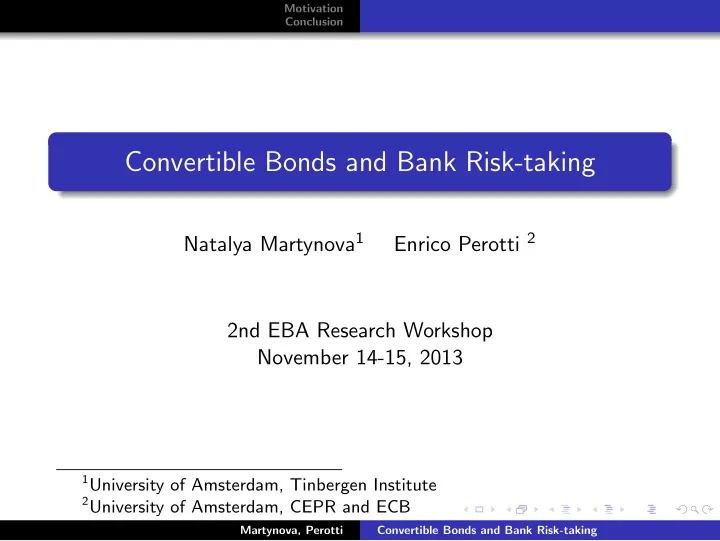

Motivation Conclusion Convertible Bonds and Bank Risk-taking Natalya Martynova 1 Enrico Perotti 2 2nd EBA Research Workshop November 14-15, 2013 1 University of Amsterdam, Tinbergen Institute 2 University of Amsterdam, CEPR and ECB Martynova, Perotti Convertible Bonds and Bank Risk-taking
Motivation Conclusion Motivation In the credit boom, high leverage drove excess risk shifting. Basel III calls for more bank capital in order to force more risk absorption (bail in at default) reduce risk incentives associated with high leverage Contingent capital proposed as an alternative to equity. CoCo bonds is a debt instrument which automatically converts into equity as going concern, when leverage becomes too high Distinct from bail-in debt, which does not contain risk shifting While not adopted under Basel III, CoCos are admitted as a component of additional capital buffers (EBA, Switzerland). Martynova, Perotti Convertible Bonds and Bank Risk-taking
Motivation Conclusion Contribution Optimal design for going-concern contingent capital to prevent endogenous risk shifting. Paper : focuses on banks’ risk control decisions in the presence of CoCos financing. CoCos assumed to substitute conventional debt (deposits) CoCos converted into equity at a fixed conversion ratio when asset values fall below a given threshold (trigger) CoCos might convert ahead of default, and at maturity they act as a junior bond. Martynova, Perotti Convertible Bonds and Bank Risk-taking
Motivation Conclusion Risk incentives As leverage increases, risk incentives start to build up non linearly. Critical to ensure conversion when leverage passes a critical threshold. Martynova, Perotti Convertible Bonds and Bank Risk-taking
Motivation Conclusion Model: Optimal trigger Without CoCos, a banker controls risk only if asset values high v > v ∗ (low leverage). With CoCos, a banker also controls risk for intermediate asset values v > v ∗ C . For high asset values v ≥ v ∗ , bank makes effort to control risk independent of the presence of CoCos For low asset values v ≤ v ∗ C , risk shifting incentives are too severe. CoCos do not change a bank’s risk choice. For intermediate leverage v ∗ C < v < v ∗ , CoCos induce bank to control risk. Martynova, Perotti Convertible Bonds and Bank Risk-taking Figure: Risk incentives with optimal trigger v ∗
Motivation Conclusion Results: Equity and CoCo dilution effects An appropriate trigger reduces risk shifting by converting in high leverage states, when incentives deteriorate. Equity dilution effect decreases the upside gains and thus reduces the benefits from risk-shifting. However, there is also a debt dilution effect. The fixed conversion ratio leads to a value transfer from CoCo to equity when asset prices are low. This may encourage risk shifting. Due to the interaction of two effects, there is an optimal amount of contingent capital, beyond which incentives deteriorate. Martynova, Perotti Convertible Bonds and Bank Risk-taking
Motivation Conclusion Market versus Regulatory Trigger Suppose both triggers noisy A market trigger produces more frequent conversion, including in some states when more capital is not necessary (type 1 error). A regulatory trigger will not be activated for some banks with moderate leverage as the regulator gambles on success (type 2 error). This leads to more risk taking for those banks. So a market trigger offers more risk reduction (and more equity in general) but causes some unnecessary conversion. A regulatory trigger causes too much forbearance. A dual trigger may be optimal, to filter out market error or price manipulation, while challenging forbearance. Martynova, Perotti Convertible Bonds and Bank Risk-taking
Motivation Conclusion Conclusion Properly designed CoCos can induce risk reduction. There exists an optimal CoCo amount that minimizes risk. The trade-off is between equity dilution and CoCos dilution effect. When asset risk and trigger precision are high, CoCos may be safer and thus cheaper than traditional bonds. A higher amount of contingent capital is required to provide the same effort incentives as equity. A dual trigger may be optimal, to filter out market manipulation while challenging forbearance. Martynova, Perotti Convertible Bonds and Bank Risk-taking
Recommend
More recommend